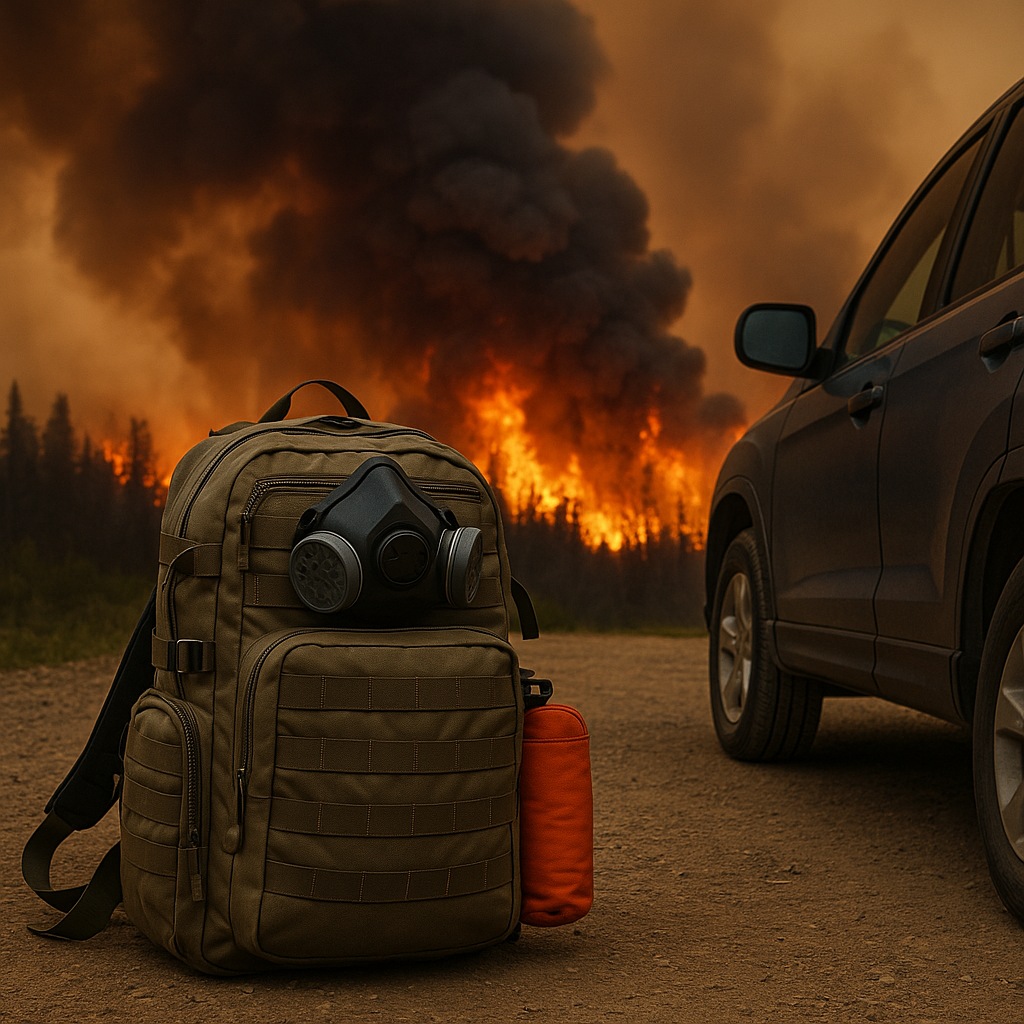Wildfires are no longer rare, seasonal concerns in Canada — they are now a dominant threat across much of the country. From the boreal forests of Alberta to the pine-dominated wilderness of Northern Ontario, the risk of a fast-moving wildfire forcing a bugout is very real. As preppers, we don’t rely on luck. We prepare, we plan, and we practice.
Here’s how to bug out smart, fast, and effectively when wildfires threaten your property or homestead.
🔥 The Wildfire Reality in Canada
Canada experienced its worst wildfire season on record in 2023, burning over 18 million hectares of land. The trend is clear: more fires, longer seasons, faster spread.
⚠️ Key Risk Factors:
- Lightning strikes (especially in boreal regions)
- Human activity (campfires, equipment, negligence)
- Extended drought and wind events
- Lack of forest management in remote regions
For preppers in forested or semi-rural areas, this creates a unique SHTF scenario: a sudden evacuation that may turn into weeks or months away from home — or the permanent loss of your primary retreat.
✅ PRE-FIRE PREP: Fire-Resistant Homestead + Bugout Planning
🛠️ 1. Fire-Hardening Your Home or Retreat
Even if you need to evacuate, fire-proofing increases the chance that your home survives and reduces risk while you’re still there.
- Defensible space: Clear brush, trees, and tall grass within 30m of buildings.
- Metal roofing and cement board or metal siding for new builds or retrofits.
- Mesh vents: Prevent ember intrusion with 1/8” screening over attic vents.
- Exterior water source: Hose bibs with long hoses or a gravity-fed water tank + fire pump.
- Keep gutters clean and roof swept during fire season.
- Fuel storage: Gasoline, propane, and diesel must be stored at least 10m away.
🧭 2. Escape Route Mapping
- Identify at least three evacuation routes (primary, secondary, and emergency).
- GPS and printed topo maps in every vehicle and bugout bag.
- Mark creek beds, gravel roads, cutlines and fire breaks on your map — these may be safer than highways.
💼 3. Pre-Staged Bugout Bins
- Waterproof totes or fire-rated ammo cans stored by your main door or in vehicle.
- Label bins: Medical, Tools, Comms, Food, Documents.
- Consider small fireproof safes for USBs, IDs, and cash.
🧯 4. Local Intel & Fire Watch
- Subscribe to provincial wildfire alerts:
- Use apps like Firesmoke Canada, Windy, and MyRadar for real-time monitoring.
🎒 BUGOUT BAG FOR FIRE SEASON: What’s Different
Wildfire evacuations differ from flood, civil unrest, or blizzard scenarios. You’re dealing with heat, smoke, poor air quality, and possibly blocked roads.
👇 Core Additions for Wildfire Bugouts:
| Gear | Purpose |
|---|---|
| N95 or P100 masks | Filter out smoke and particulates |
| Goggles | Protect eyes from smoke, ash, embers |
| Wool or Nomex gloves | Heat-resistant, avoid synthetics |
| Headlamp + batteries | Navigate at night or in smoke |
| Fire blanket or bivy | Last-resort protection |
| 2-way radios + spare battery | If cell towers are down |
| High-calorie food bars | Fast energy on the move |
| Water filter + collapsible containers | Stay light, refill on route |
| Copies of ID, land titles, insurance | Stored in waterproof/fireproof pouch |
Keep seasonal items nearby — winter gear if fire season is extending into September or October.
🚨 THE MOMENT ARRIVES: EXECUTING THE BUGOUT
When you smell smoke or authorities declare an evacuation:
✅ 1. Stick to Your Checklist
Have a written evacuation list and grab:
- Bugout bag(s)
- Fireproof doc pouch
- Hard drives or backup media
- Cash & fuel cards
- Pets, leashes, kennels
- Pre-filled gas cans (rotate regularly)
⛽ 2. Get Out Fast, Stay Ahead
Don’t wait to be trapped. Fires can jump roads and cover kilometres in minutes. If authorities say go — GO. If you’re unsure, go anyway and reassess from a safe location.
📍 3. Navigation in Crisis
- Use real-time GPS and mark detours.
- Be prepared to drive off-road if needed — have tire repair tools, tow strap, and traction boards.
- Know how to find safe zones (large parking lots, quarries, cut blocks, lakes).
🛖 AFTER THE BUGOUT: Temporary Living + Long-Term Plans
Wildfires often mean long-term displacement. Here’s how to manage it:
🏕️ 1. Fallback Sites
Have backup locations:
- Remote cabins or Crown land camps
- Friend or prepper mutual aid retreats
- Hidden caches with gear, food, fuel
🔒 2. Offsite Caching
Use water-tight barrels or ammo cans buried or hidden in protected zones:
- Store fuel tablets, food, fire kits, sleeping gear, comms, first aid.
🧾 3. Documentation and Recovery
If your property is lost:
- Document all expenses
- Take video/photos of your return
- File with insurance and begin long-term rebuild or relocation strategy
🧠 Mental Readiness: The Forgotten Gear
Being mentally prepared to leave everything behind is perhaps the hardest part. Your homestead, garden, tools, and even livestock may be lost. But your survival, and that of your family, must come first.
Train for it.
Rehearse evacuation.
Drill with your family.
Know your gear, your route, and your role.
🔚 Conclusion: Bugging Out Is Not Failure — It’s Strategy
For preppers in Canada, wildfire season is not just a seasonal inconvenience. It’s a serious threat that could force you off your land in hours. Treat fire as one of the few scenarios where bugging out is the right move — and possibly your only move.
Preparation is protection. Inaction is risk.
You’ve already chosen the prepper path — finish the work. Fire doesn’t wait.



